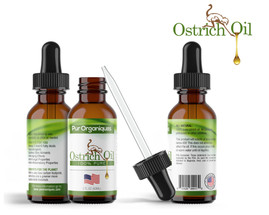Jul 19th 2019
Why Ostrich Oil?
Ostrich oil comes from the fat of the ostrich, which is found between the ostrich’s muscle and skin. The biggest flightless bird in the world, the Ostrich has been a valuable source of food, leather, and personal care purposes for thousands of years for many native tribes. For centuries ostrich oil has been used by Egyptian, Roman and African cultures for the relief of dry skin, burns, lesions, eczema, sunburn, and even dry hair.
BUY NOW FOR ONLY $14.95
Ostriches provide dietetic meat, valuable skins, feathers, eggs, and especially oil. Ostrich oil has been used by the Egyptian, Roman & African cultures for over 3000 years for topical relief of skin conditions such as dry skin, burns, lesions, contact dermatitis, eczema, psoriasis, sunburn, chapped lips, athlete's foot, dry hair, fine lines and wrinkles, softening callused skin, and for the treatment of minor cuts and scratches.
Ostrich oil contains a high concentrate of healing Omega Essential Fatty Acids, Omega 6 (Linoleic), Omega 9 (Oleic), and Essential Fatty Acids (EFA’s). These all natural skin moisturizing and conditioning properties make Ostrich Oil a beneficial ingredient for today's skin care products. Ostrich oil also contains variable levels of compounds including carotenoids, flavones, polyphenols, tocopherol and phospholipids in the non-triglyceride fraction, which present therapeutic benefits including antioxidant properties.
The Omega 3, 6 and 9 fatty acids which promote the growth of new skin cells and are naturally rich in vitamins well known for skin rejuvenation. Ostrich Oil’s anti-inflammatory properties make it ideal for relief for arthritis, muscle and joint pain, insect bites, stretch marks, sprains, rashes, aging, wrinkles, hemorrhoids, and as a massage oil.
Ostrich Oil is an exceptional moisturizing, penetrating, and therapeutic oil that absorbs quickly and provides luxurious moisture for hours. The oil proves moisture without clogging skin pores or leaving your skin feeling greasy. It is safe for humans and animals. The benefits of ostrich oil include:
- Skin moisturizer - Gentle enough to apply multiple times per day. For an added benefit, it can also be applied as an emollient before bedtime. Since ostrich oil is absorbed quickly by the skin, it does not leave your skin feeling tacky or sticky.
- Anti-aging effects - Ostrich oil has potent anti-aging properties and it is therefore useful in maintaining a youthful appearance. It lowers the formation of several symptoms of aging, including wrinkles and under eye bags. The fatty acids found in ostrich oil are vital for cell division, recovery, and growth.
- Anti-Inflammatory properties - Research has shown that linoleic acid, when applied topically on the skin, has anti-inflammatory, acne reduction and moisture maintenance properties. This particular oil may be used as a major part of skin cleansing as it does not clog skin pores.
- Support of nervous, heart and immune system - EFAs are nutritionally important since they act as precursors to a group of hormone-like substances known aseicosanoids which include prostaglandins, thromboxanes, and prostacyclins that help in regulating the central nervous system, blood pressure, heart rate and also play a role in the immune system by regulating inflammation and motivating our body to fight against infections. Omega-6 fatty acids are generally necessary for growth development, regulating metabolism, promoting the carrying of fatty acids from the liver to the tissues and maintaining reproductive performance (Palanisamy et al., 2011).
Ostrich Oil composition
Fatty acids (FAs) represent the predominating component of ostrich oil, with a lipid content of 98.8% for subcutaneous adipose tissue, and 98.0% for retroperitoneal adipose tissue. Ostrich oil comprises approximately 42% oleic acid, 21% linoleic acid, and 21% palmitic acid, with lower levels of other FAs, including 1% a-linolenic acid. More recently, Beckerbauer et al. demonstrated that Ostriches fed a diet rich in unsaturated fat (soybean oil) produced oil that was more polyunsaturated compared with ostrich fed a diet rich in saturated fat. These findings indicate that diet composition can significantly influence the composition of ostrich oil and hence possibly impact on oil efficacy (Abimosleh et al., 2012).
Ostrich oil contains Omega 6 (Linoleic), Omega 9 (Oleic), Essential Fatty Acids (EFA’s), and certain Vitamins and Amino Acids to help maintain the health of your skin membranes. These omega oils cause the Ostrich to have the most powerful immune system of any land animal. These properties promote healthy and youthful skin, penetrating deeply into the skin providing luxurious moisture for hours without clogging pores, unlike petroleum-based products.
Ostriches convert the vegetable oil in seeds to an animal fat that is extremely high in EFA’s. The Myelin Sheath, which insulates our nerves, consists of EFA’s and when the body lacks these, our nerves become irritated and inflamed which can cause many nerve and skin conditions. Because it replenishes the EFA’s, it is naturally soothing.
Figure 1. Ostrich oil compositions
Figure 2. Chemical structures of common fatty acids presented in ostrich oil
Our Ostriches are fed a vegetarian, all natural feed so there is no introduction of animal by-products, growth hormones or antibiotics in the oil. This means the pure natural oil is great for your skin. For all of these reasons, ostrich oils are used widely in the cosmetics and pharmaceutical industry.

